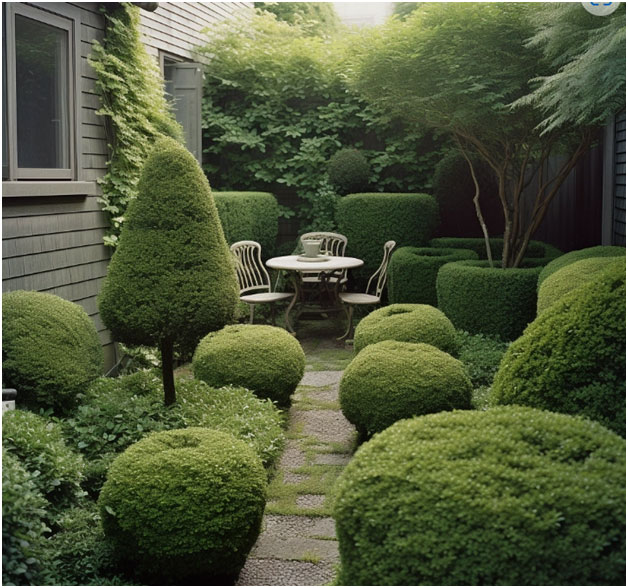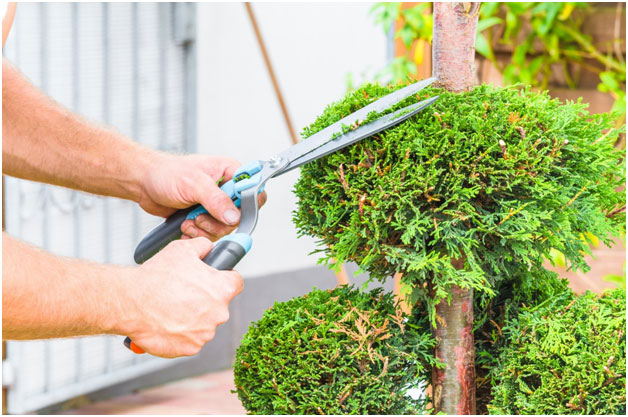
Compact Topiary Magic: Beautifying Small Spaces with Living Art
The practice of topiary gardening has resulted in many fantastic large-scale planting since ancient Roman times. But topiary gardening canbe the perfect option for small planting spaces as well. At topiarytree.net, we have an extensive collection of compact, customizable topiaries. But if you want to learn more about growing topiaries in small spaces before purchasing, read this article.
Ideal Topiary Trees for Small Spaces
There are many factors to consider when choosing a topiary plant, but if you are working with a compact space, the overall size of your topiary is the most important characteristic. You can always manage the size of your topiary through trimming and maintenance, but it also helps to select a topiary plant species that have a relatively small overall mature size. Here are a few of the best options:
- Boxwood
- ‘Boulevard’ false cypress
- Dwarf Alberta spruce
- Eugenia
- ‘Spartan’ Chinese juniper

Image by TopiaryTree.net
Topiary Shapes and Styles
You’ll be happy to know that there are plenty of topiary styles that you can follow, including both classic and modern options. Some of the most traditional topiary styles include the following shapes:
- Spheres
- Cubes
- Cones
- Pyramids
- Spirals
In addition to those classic shapes, you can also go for a more modern look by creating abstract topiary shapes. Furthermore, you’ll also have the option to make elaborate topiary shapes, including those that resemble human and animal forms.
Ultimately, the decision of what topiary style you’ll choose is up to you. But you should also know that if you are unable to find a topiary shape that pleases your eye, topiarytree.net has plenty of customization options.
Topiaries for Balconies and Patios
If your compact growing space is on a balcony or patio, you’ll need to take time to select a suitable container and factor in how much sunlight the area receives.
Regarding containers, it is most important to select one that is large enough for your plant and has excellent drainage. After meeting those functional requirements, you can then select containers based on their aesthetic appeal.
It’s also important to study how much sunlight your patio or balcony receives. Then, make sure you select a topiary plant that is well suited to that level of sun exposure.
Indoor Topiary Trees
Growing topiaries indoors can be a bit more challenging. One of the main challenges is that indoor growing locations often don’t receive enough sunlight. As such, it helps to choose topiary species that adapt well to areas that receive relatively low light.
However, if you want to avoid sun exposure issues entirely, you might be best off choosing an artificial topiary tree. Fortunately, at topiarytree.net, we carry both artificial and natural topiary trees that can work well in indoor settings.
Vertical Topiaries
For those who are especially lacking in growing space, the only option may be to adopt a vertical approach to topiary gardening. This means that you’ll be using wall-mounted planters, topiary plants that climb on trellises, and green walls. By planting vertically, you can fit beautiful topiary plants into some of the smallest of growing locations. Again, topiarytree.net is the best place to start if you are looking for these planting options.

Topiary Maintenance
Perhaps the most important aspect of topiary maintenance is trimming and pruning. Trimming and pruning your topiaries regularly is what allows you to maintain their perfect shape and overall health.
In addition to trimming, you’ll also need to study the specific growing needs of the species you own. Each plant species requires water and fertilizer in different amounts and on different schedules.
The last important maintenance task of note is pest prevention. Typically, giving your plants the right growing conditions and care will help them remain healthy and pest free. However, it’s also important to monitor your plants regularly so that you can notice and address any pest issues as soon as they arise.
Creative Display Ideas
As you might guess, one of the best ways to display your topiary plant is as a distinct focal point within your garden. Since topiaries have such outstanding shapes, they deserve to take center stage in your garden.
With that said, topiaries can also look fantastic when you plant them in groups. You can also mix your topiaries with other non-topiary plants to create more variety in your planting scheme.
DIY Topiary
You have the option to buy a plant that has already been trained to be a topiary. As an alternative, you can perform DIY topiary on your own.
If you take the DIY approach, it is best to begin when the plant is very young. During the early stages of your plant’s life, you’ll want to shape and prune it to guide its future growth into the shape that you desire.
Of course, you’ll need to continue pruning continuously throughout your plant’s life, but training the plant while it is young is especially important.
Buying Pre-Made Topiaries
If the DIY approach is not right for you, you must purchase a pre-made topiary tree. However, not all pre-made trees are of equal quality.
Before settling on a pre-made topiary, you should ensure that it is a suitable species for your growing location. You should also evaluate its overall health by observing the leaves and branches for any signs of disease, damage, or general lack of vigor.
Once you purchase one of these trees, you should be prepared to transplant it. This often involves roughing up the root ball to loosen the roots and planting the tree in a hole or container that is about twice as wide as the root ball.
Summary
Topiaries are amazing plants, and they are not exclusive to large growing areas. As this article proves, topiaries can be the perfect option for compact areas if you know what to look for and are willing to be a bit creative. As always, if you need support on your topiary project, reach out to topiarytrees.net for the best products and advice on the topic.
FAQs
How Often Do You Need to Water Topiaries?
The frequency with which you water your topiaries depends on the species you own. Many topiary plants will do well if you give them water about once per week or once every other week. In general, you can expect to increase your watering frequency during the hotter months of the year and curb it during the winter.
When is the Best Time to Prune a Topiary Tree?
Often, the best time to perform major pruning for a topiary tree is during the late winter and early spring when the plant is exiting its dormancy phase. However, for topiaries, you’ll also need to continue pruning and trimming throughout the year to maintain the plant’s shape.
How Do You Maintain the Shape of Your Topiaries?
The ideal way to maintain your topiary tree’s shape is through shearing. While selective pruning involves cutting individual branches, shearing is all about cutting the exterior foliage of the plant. Any time that your topiary begins to lose its shape, you can quickly correct it by shearing it back into its ideal form.
Sources:
https://www.britannica.com/art/topiary
Featured Image by Deposit Photos ID 42534269
In Post Image 2 by Deposit Photos ID 94513570